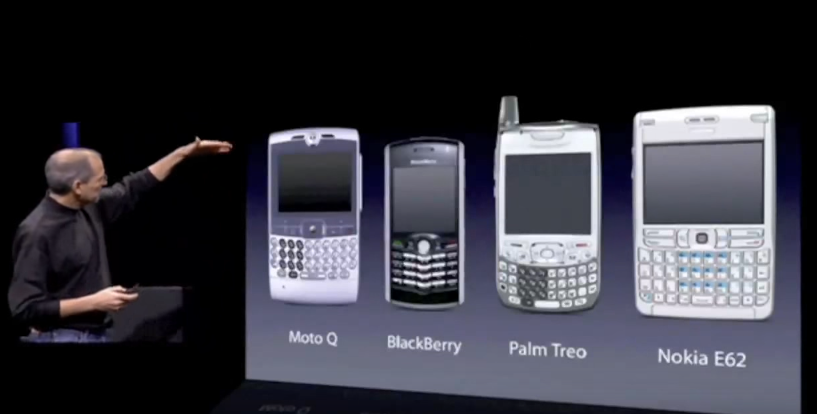The Motorola Q, launched by Verizon in 2006
Steve Jobs pointed to a screen with a number of smartphones displayed, and called them "the usual suspects." He was talking about
the state of the smartphone market on January 9th, 2007. The Apple CEO was about to change the smartphone market forever with the unveiling of the
Apple iPhone, and one of the handsets that he was aiming at was the
Motorola Q. The Q was very much like other smartphones of the time. That's to say that it featured a rectangular glass display (non touchscreen) with a physical QWERTY keyboard, and a camera in back.
Both the CDMA and GSM versions of the Motorola Q were unveiled on July 26th 2005.
Verizon launched the phone on May 31st 2006 with a version for Sprint launched the following January. The device featured a thumb wheel on the right side and a 1.3MP camera adorned the back of the unit. A 1130mAh battery powered the Motorola Q. Windows Mobile Standard 5.0 was running the show. 64MB of internal memory was inside with a microSD slot available for those who needed additional storage. The screen offered a landscape view and featured a resolution of 320 x 240.
Bell Mobility launched the GSM version of the phone on November 13th 2006, and was the first carrier to offer the device in black. On June 29th, the Apple iPhone was launched as an AT&T exclusive. But Motorola wasn't looking to compete with the iPhone at that point. The main goal was to take on BlackBerry. Just one month after the iPhone was released, the Motorola updated the Q and launched the Motorola Q9. In July, the
Motorola Q9h launched in Europe and in the U.S. via Bell Mobility. One month later, the
Motorola Q9m was made available at Verizon.
The Motorola Q9 featured a 2.4-inch display with the same 320 x 240 resolution. A single-core 325MHz CPU was under the hood with 96MB of RAM and 250MB of native storage inside. An 8GB microSD slot was available for those seeking additional storage. On back was a 2MP camera, and it was all powered by an 1170mAh battery. Windows Mobile Standard 6.0 was pre-installed.
By November 2009, Verizon was desperate for an iPhone competitor. The year before, the
BlackBerry Storm launched half baked, leaving Verizon without an answer to AT&T's exclusive. By then, Motorola had the answer in the Android powered
Motorola DROID. And while Motorola gave the Q another shot with the
Q11 in 2008 (which added support for Wi-Fi), the ball game was over. Touch screen smartphones were taking over, and phones like the usual suspects mentioned by Steve Jobs were taking their last breaths.
Steve Jobs introduces the usual suspects on January 9th, 2007. The Motorola Q is first on the left
Read the latest from Alan Friedman















Things that are NOT allowed:
To help keep our community safe and free from spam, we apply temporary limits to newly created accounts: